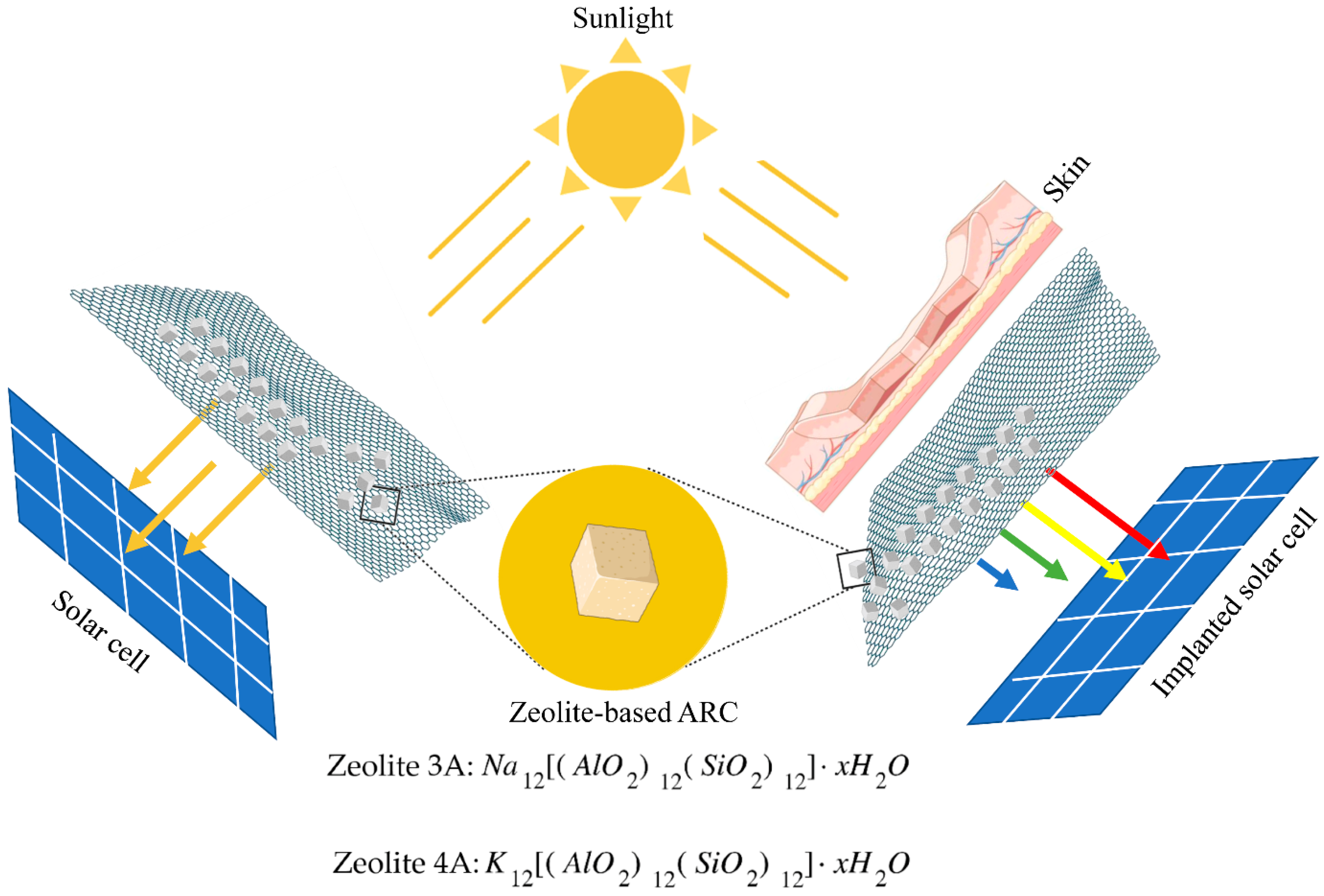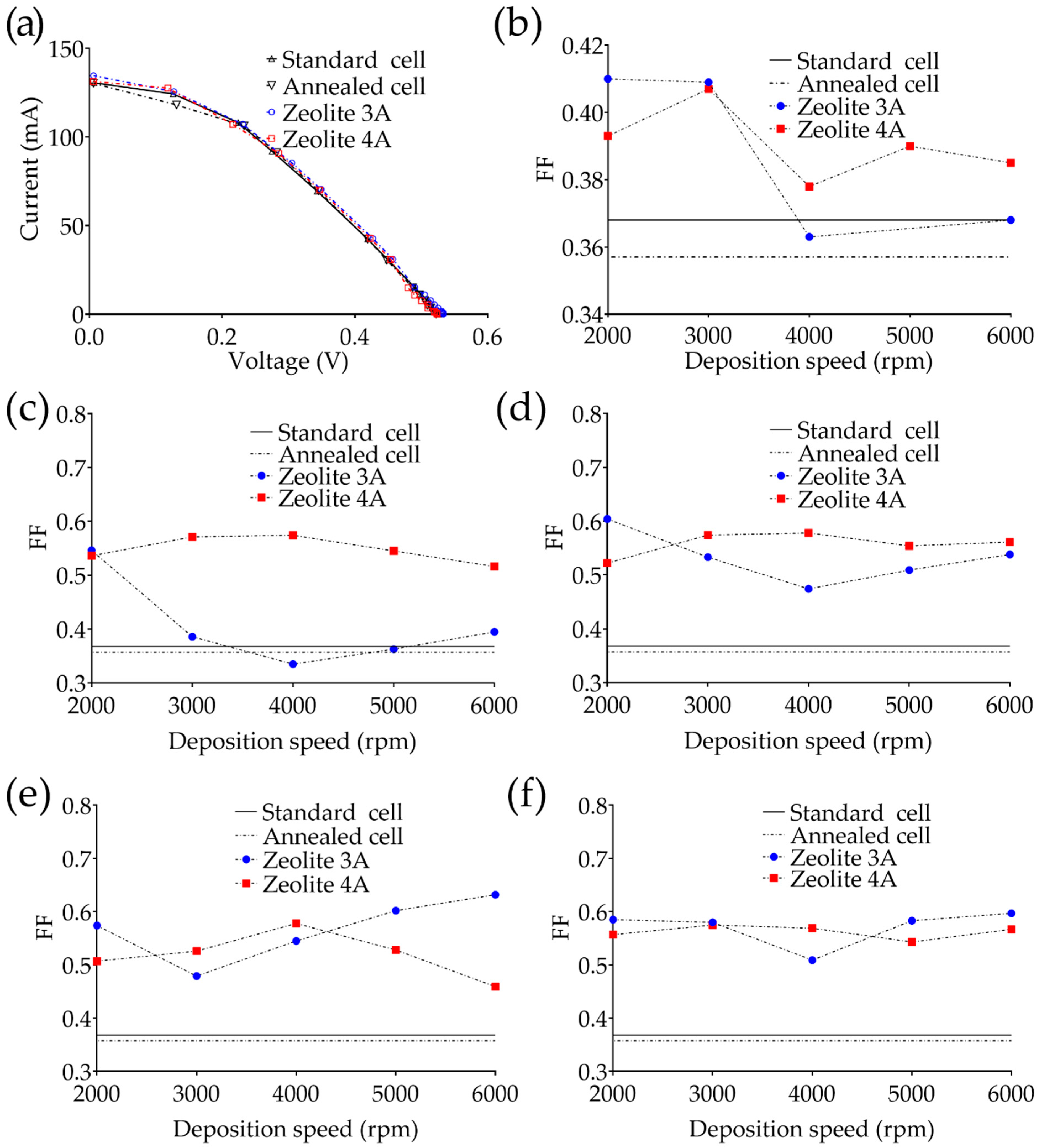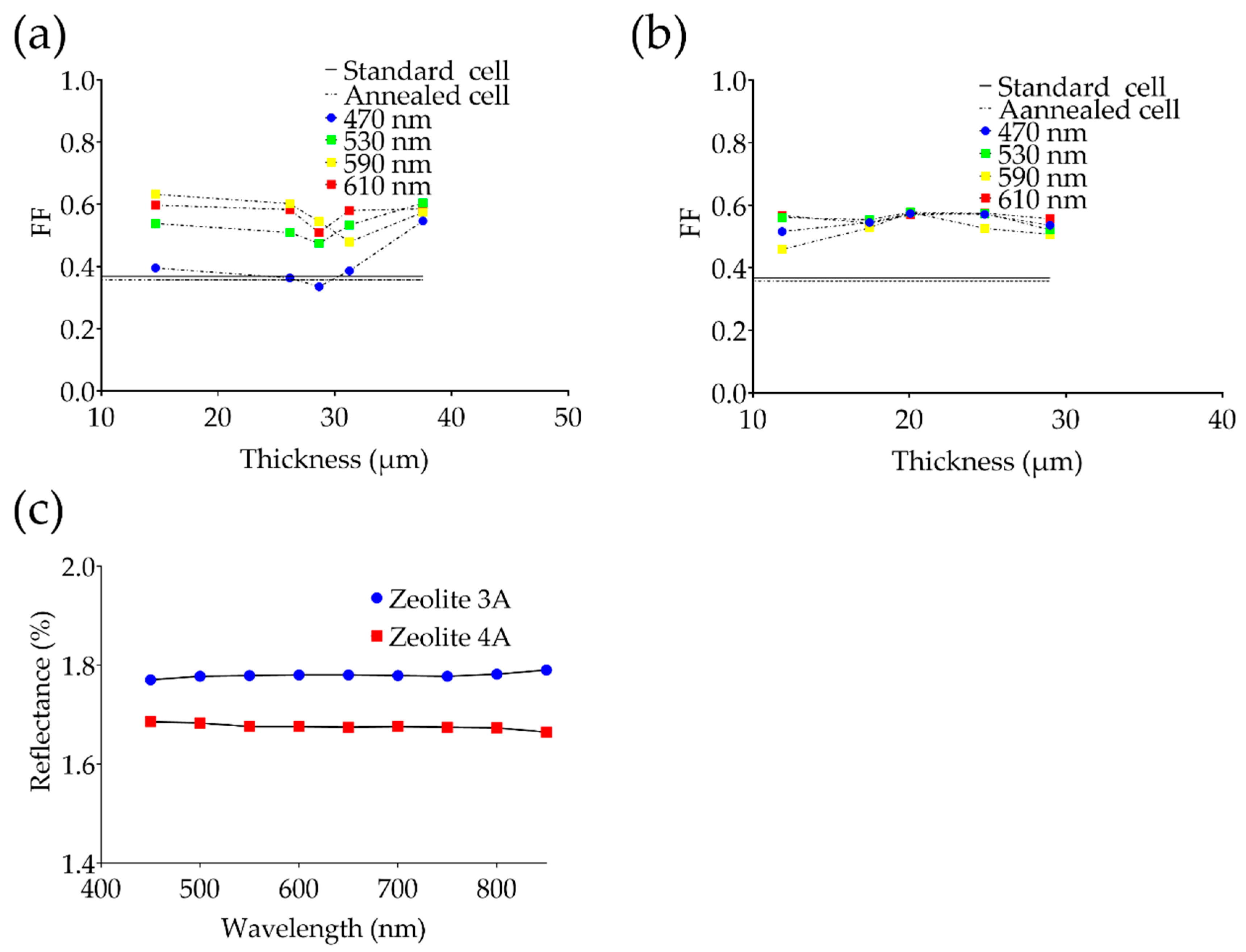Anti-Reflective Zeolite Coating for Implantable Bioelectronic Devices
Abstract
:1. Introduction
2. Materials and Methods
3. Results
4. Discussion
5. Conclusions
Author Contributions
Funding
Institutional Review Board Statement
Informed Consent Statement
Data Availability Statement
Conflicts of Interest
References
- Roller, S. Reducing energy demand: A review of issues, challenges and approaches. Renew. Sustain. Energy Rev. 2015, 47, 74–82. [Google Scholar] [CrossRef] [Green Version]
- Barton, J.P.; Thomson, M. Solar Power and Energy Storage for Decarbonization of Land Transport in India. Energies 2021, 14, 8277. [Google Scholar] [CrossRef]
- Pursiheimo, E.; Holttinen, H.; Koljonen, T. Inter-sectoral effects of high renewable energy share in global energy system. Renew. Energy 2019, 136, 1119–1129. [Google Scholar] [CrossRef]
- Owczarek, M. Thermal Fluxes and Solar Energy Storage in a Massive Brick Wall in Natural Conditions. Energies 2021, 14, 8093. [Google Scholar] [CrossRef]
- Maaouane, M.; Zouggar, S.; Krajačić, G.; Zahboune, H. Modelling industry energy demand using multiple linear regression analysis based on consumed quantity of goods. Energy 2021, 225, 120270. [Google Scholar] [CrossRef]
- Jiménez Mejía, K.; Barbero-Barrera, M.d.M.; Rodríguez Pérez, M. Evaluation of the Impact of the Envelope System on Thermal Energy Demand in Hospital Buildings. Buildings 2020, 10, 250. [Google Scholar] [CrossRef]
- Hartley, T.; Lemire, G.; Kernohan, K.D.; Howley, H.E.; Adams, D.R.; Boycott, K.M. New Diagnostic Approaches for Undiagnosed Rare Genetic Diseases. Annu. Rev. Genom. Hum. Genet. 2020, 21, 351–372. [Google Scholar] [CrossRef] [Green Version]
- Rajula, H.S.R.; Verlato, G.; Manchia, M.; Antonucci, N.; Fanos, V. Comparison of Conventional Statistical Methods with Machine Learning in Medicine: Diagnosis, Drug Development, and Treatment. Medicina 2020, 56, 455. [Google Scholar] [CrossRef]
- Kumar, R.; Nagpal, S.; Kaushik, S.; Mendiratta, S. COVID-19 diagnostic approaches: Different roads to the same destination. VirusDisease 2020, 31, 97–105. [Google Scholar] [CrossRef]
- Pullano, S.A.; Greco, M.; Bianco, M.G.; Foti, D.; Brunetti, A.; Fiorillo, A.S. Glucose biosensors in clinical practice: Principles, limits and perspectives of currently used devices. Theranostics 2022, 12, 493–511. [Google Scholar] [CrossRef]
- Teixeira, E.; Fonseca, H.; Diniz-Sousa, F.; Veras, L.; Boppre, G.; Oliveira, J.; Pinto, D.; Alves, A.J.; Barbosa, A.; Mendes, R.; et al. Wearable Devices for Physical Activity and Healthcare Monitoring in Elderly People: A Critical Review. Geriatrics 2021, 6, 38. [Google Scholar] [CrossRef] [PubMed]
- Pullano, S.A.; Critello, C.D.; Fiorillo, A.S. Triboelectric-Induced Pseudo-ICG for Cardiovascular Risk Assessment on Flexible Electronics. Nano Energy 2019, 67, 104278. [Google Scholar] [CrossRef]
- Wang, S.; Geng, G.; Ma, J.; Jiang, Q.; Huang, H.; Lou, B. Operational Bottleneck Identification based Energy Storage Investment Requirement Analysis for Renewable Energy Integration. IEEE Trans. Sustain. Energy 2020, 12, 92–102. [Google Scholar] [CrossRef]
- Dong, L.; Jin, C.; Closson, A.B.; Trase, I.; Richards, H.R.; Chen, Z.; Zhang, J.X.J. Cardiac energy harvesting and sensing based on piezoelectric and triboelectric designs. Nano Energy 2020, 76, 105076. [Google Scholar] [CrossRef]
- Zhao, J.; Ghannam, R.; Htet, K.O.; Liu, Y.; Law, M.; Roy, V.A.L.; Michel, B.; Imran, A.I.; Heidari, H. Self-Powered Implantable Medical Devices: Photovoltaic Energy Harvesting Review. Advanced Healthc. Mater. 2020, 9, 2000779. [Google Scholar] [CrossRef]
- Kozalakis, K.; Sofianidis, I.; Konstantakos, V.; Siozios, K.; Siskos, S. 73.5 µW Indoor-Outdoor Light Harvesting System with Global Maximum Power Point Tracking. J. Low Power Electron. Appl. 2021, 11, 10. [Google Scholar] [CrossRef]
- Zaszczyńska, A.; Gradys, A.; Sajkiewicz, P. Progress in the Applications of Smart Piezoelectric Materials for Medical Devices. Polymers 2020, 12, 2754. [Google Scholar] [CrossRef]
- Biswas, D.K.; Sinclair, M.; Le, T.; Pullano, S.A.; Fiorillo, A.S.; Mahbub, I. Modeling and Characterization of Scaling Factor of Flexible Spiral Coils for Wirelessly Powered Wearable Sensors. Sensors 2020, 20, 2282. [Google Scholar] [CrossRef] [Green Version]
- Tasneem, N.T.; Pullano, S.A.; Critello, C.D.; Fiorillo, A.S.; Mahbub, I. A Low-Power On-chip ECG Monitoring System Based on MWCNT/PDMS Dry Electrodes. IEEE Sens. J. 2020, 20, 12799–12806. [Google Scholar] [CrossRef]
- Nordin, N.A.; Mohamed Ansari, M.N.; Nomanbhay, S.; Hamid, N.; Tan, N.M.L.; Yahya, Z.; Abdullah, I. Integrating Photovoltaic (PV) Solar Cells and Supercapacitors for Sustainable Energy Devices: A Review. Energies 2021, 14, 7211. [Google Scholar] [CrossRef]
- Tholl, M.V.; Akarçay, H.G.; Tanner, H.; Niederhauser, T.; Zurbuchen, A.; Frenz, M.; Haeberlin, A. Subdermal solar energy harvesting—A new way to power autonomous electric implants. Appl. Energy 2020, 269, 114948. [Google Scholar] [CrossRef]
- Sun, L.; Cheng, C.; Wang, S.; Tang, J.; Xie, R.; Wang, D. Bioinspired, Nanostructure-Amplified, Subcutaneous Light Harvesting to Power Implantable Biomedical Electronics. ACS Nano 2021, 15, 12475–12482. [Google Scholar] [CrossRef] [PubMed]
- Schulze, P.S.C.; Bett, A.J.; Bivour, M.; Caprioglio, P.; Gerspacher, F.M.; Kabaklı, Ö.Ş.; Richter, A.; Stolterfoht, M.; Zhang, Q.; Neher, D.; et al. 25.1% High-Efficiency Monolithic Perovskite Silicon Tandem Solar Cell with a High Bandgap Perovskite Absorber. Sol. RRL 2020, 4, 2000152. [Google Scholar] [CrossRef]
- Min, H.; Lee, D.Y.; Kim, J.; Kim, G.; Lee, K.S.; Kim, J.; Paik, M.J.; Kim, Y.K.; Kim, K.S.; Kim, M.G.; et al. Perovskite solar cells with atomically coherent interlayers on SnO2 electrodes. Nature 2021, 598, 444–450. [Google Scholar] [CrossRef] [PubMed]
- Al-Ashouri, A.; Köhnen, E.; Li, B.; Magomedov, A.; Hempel, H.; Caprioglio, P.; Márquez, J.A.; Morales Vilches, A.B.; Kasparavicius, E.; Smith, J.A.; et al. Monolithic perovskite/silicon tandem solar cell with >29% efficiency by enhanced hole extraction. Science 2020, 370, 1300–1309. [Google Scholar] [CrossRef] [PubMed]
- Ritzer, D.B.; Abzieher, T.; Basibüyük, A.; Feeney, T.; Laufer, F.; Ternes, S.; Richards, B.S.; Bergfeld, S.; Paetzold, U.W. Upscaling of perovskite solar modules: The synergy of fully evaporated layer fabrication and all-laser-scribed interconnections. Prog. Photovolt. 2021, 30, 360–373. [Google Scholar] [CrossRef]
- Karin, T.; Miller, D.; Jain, A. Nondestructive Characterization of Antireflective Coatings on PV Modules. IEEE J. Photovolt. 2021, 11, 760–769. [Google Scholar] [CrossRef]
- Raut, H.K.; Ganesh, V.A.; Nair, A.S.; Ramakrishna, S. Anti-reflective coatings: A critical, in-depth review. Energy Environ. Sci. 2011, 4, 3779. [Google Scholar] [CrossRef]
- Lee, Y.; Woo, Y.; Lee, D.-K.; Kim, I. Fabrication of quasi-hexagonal Si nanostructures and its application for flexible crystalline ultrathin Si solar cells. Sol. Energy 2020, 208, 957–965. [Google Scholar] [CrossRef]
- Shanmugam, N.; Pugazhendhi, R.; Madurai Elavarasan, R.; Kasiviswanathan, P.; Das, N. Anti-Reflective Coating Materials: A Holistic Review from PV Perspective. Energies 2020, 13, 2631. [Google Scholar] [CrossRef]
- Duttagupta, S.; Ma, F.; Hoex, B.; Mueller, T.; Aberle, A.G. Optimised Antireflection Coatings using Silicon Nitride on Textured Silicon Surfaces based on Measurements and Multidimensional Modelling. Energy Procedia 2012, 15, 78–83. [Google Scholar] [CrossRef] [Green Version]
- Sahoo, M.K.; Kale, P. Integration of silicon nanowires in solar cell structure for efficiency enhancement: A review. J. Mater. 2018, 5, 34–48. [Google Scholar] [CrossRef]
- Wang, Y.; Wang, H.; Chen, M.; Wang, P.; Mao, Y.; Han, W.; Wang, T.; Liu, D. Bilayer broadband antireflective coating to achieve planar heterojunction perovskite solar cells with 23.9% efficiency. Sci. China Mater. 2020, 64, 789–797. [Google Scholar] [CrossRef]
- Soonmin, H. A Review of Metal Oxide Thin Films in Solar Cell Applications. Int. J. Thin Film Sci. Technol. 2022, 11, 37–45. [Google Scholar] [CrossRef]
- Peng, Y.-J.; Huang, H.-X.; Xie, H. Rapid fabrication of antireflective pyramid structure on polystyrene film used as protective layer of solar cell. Sol. Energy Mater. Sol. Cells 2017, 171, 98–105. [Google Scholar] [CrossRef]
- Liu, X.; Cheng, K.; Cui, P.; Qi, H.; Qin, H.; Gu, G.; Shang, W.; Wang, S.; Cheng, G.; Du, Z. Hybrid energy harvester with bi-functional nano-wrinkled anti-reflective PDMS film for enhancing energies conversion from sunlight and raindrops. Nano Energy 2019, 66, 104188. [Google Scholar] [CrossRef]
- Bacal, D.M.; Lal, N.N.; Jumabekov, A.N.; Hou, Q.; Hu, Y.; Lu, J.; Chesman, A.S.R.; Bach, U. Solution-processed antireflective coating for back-contact perovskite solar cells. Opt. Express 2020, 28, 12650–12660. [Google Scholar] [CrossRef]
- Kim, S.; Cho, J.; Char, K. Thermally Stable Antireflective Coatings Based on Nanoporous Organosilicate Thin Films. Langmuir 2007, 23, 6737–6743. [Google Scholar] [CrossRef]
- Stetsenko, M.; Pullano, S.A.; Margitych, T.; Maksimenko, L.; Hassan, A.; Kryvyi, S.; Hu, R.; Huang, C.; Ziniuk, R.; Golovynskyi, S.; et al. Antireflection Enhancement by Composite Nanoporous Zeolite 3A–Carbon Thin Film. Nanomaterials 2019, 9, 1641. [Google Scholar] [CrossRef] [Green Version]
- Pullano, S.A.; Rudenko, S.P.; Stetsenko, M.O.; Maksimenko, L.S.; Krishchenko, I.M.; Synyuk, V.S.; Fiorillo, A.S. Antireflection properties of composite zeolite gold nanoparticles film. Electron. Lett. 2018, 54, 370–372. [Google Scholar] [CrossRef]
- Fiorillo, A.S.; Tiriolo, R.; Pullano, S.A. Absorption of Urea into Zeolite Layer Integrated with Microelectronic Circuits. IEEE Trans. Nanotechnol. 2015, 15, 214–217. [Google Scholar] [CrossRef]
- Divband, B.; Rashidi, M.R.; Khatamian, M.; Kazemi Eslamian, G.R.; Gharehaghaji, N.; Dabaghi Tabriz, F. Linde Type A and nano magnetite/NaA zeolites: Cytotoxicity and doxorubicin loading efficiency. Open Chem. 2018, 16, 21–28. [Google Scholar] [CrossRef] [Green Version]
- Serati-Nouri, A.; Jafari, A.; Roshangar, L.; Dadashpour, M.; Pilehvar-Soltanahmadi, Y.; Zarghami, N. Biomedical applications of zeolite-based materials: A review. Mater. Sci. Eng. C 2020, 116, 111225. [Google Scholar] [CrossRef]
- Salehi, H.; Mehrasa, M.; Nasri-Nasrabadi, B.; Doostmohammadi, M.; Seyedebrahimi, R.; Davari, N.; Rafienia, M.; Hosseinabadi, M.E.; Agheb, M.; Siavash, M. Effects of nanozeolite/starch thermoplastic hydrogels on wound healing. J. Res. Med. Sci. 2017, 22, 110. [Google Scholar] [CrossRef] [PubMed]
- Bacakova, L.; Vandrovcova, M.; Kopova, I.; Jirka, I. Applications of zeolites in biotechnology and medicine—A review. Biomater. Sci. 2018, 6, 974–989. [Google Scholar] [CrossRef] [PubMed]
- Akmammedov, R.; Huysal, M.; Isik, S.; Senel, M. Preparation and Characterization of Novel Chitosan/Zeolite Scaffolds for Bone Tissue Engineering Applications. Int. J. Polym. Mater. Polym. Biomater. 2018, 67, 110–118. [Google Scholar] [CrossRef]
- Zarrintaj, P.; Mahmodi, G.; Manouchehri, S.; Mashhadzadeh, A.H.; Khodadadi, M.; Servatan, M.; Ganjali, M.R.; Azambre, B.; Kim, S.-J.; Ramsey, J.D.; et al. Zeolite in tissue engineering: Opportunities and challenges. MedComm 2020, 1, 5–34. [Google Scholar] [CrossRef]
- Coluccio, M.L.; Pullano, S.A.; Vismara, M.F.M.; Coppedè, N.; Perozziello, G.; Candeloro, P.; Gentile, F.; Malara, N. Emerging Designs of Electronic Devices in Biomedicine. Micromachines 2020, 11, 123. [Google Scholar] [CrossRef] [Green Version]
- Gupta, D.; Mukhopadhyay, S.; Narayan, K.S. Fill factor in organic solar cells. Sol. Energy Mater. Sol. Cells 2010, 94, 1309–1313. [Google Scholar] [CrossRef]
- Wangatia, L.M.; Yang, S.; Zabihi, F.; Zhu, M.; Ramakrishna, S. Biomedical electronics powered by solar cells. Curr. Opin. Biomed. Eng. 2020, 13, 25–31. [Google Scholar] [CrossRef]
- Ramizy, A.; Aziz, W.J.; Hassan, A.; Omar, K.; Ibrahim, K. The effect of porosity on the properties of silicon solar cell. Microelectron. Int. 2010, 27, 117–120. [Google Scholar] [CrossRef]
- Chaibi, A.; Boucheffa, Y.; Bendjaballah-Lalaoui, N. TGA investigation of water and ethanol adsorption over LTA zeolites. Microporous Mesoporous Mater. 2021, 324, 111285. [Google Scholar] [CrossRef]
- Zhang, J.; Yu, J. Layer-by-Layer Approach to Superhydrophobic Zeolite Antireflective Coatings. Chin. J. Chem. 2017, 36, 51–54. [Google Scholar] [CrossRef] [Green Version]
- Hsu, W.-J.; Huang, P.-S.; Huang, Y.-C.; Hu, S.-W.; Tsao, H.-K.; Kang, D.-Y. Zeolite-Based Anti-Fogging Coating via Direct Wet Deposition. Langmuir 2019, 35, 2538–2546. [Google Scholar] [CrossRef]
- Choi, E.H. Aging of the Skin Barrier. Clin. Dermatol. 2019, 37, 336–345. [Google Scholar] [CrossRef] [PubMed]
- Ash, C.; Dubec, M.; Donne, K.; Bashford, T. Effect of wavelength and beam width on penetration in light-tissue interaction using computational methods. Lasers Med. Sci. 2017, 32, 1909–1918. [Google Scholar] [CrossRef]
- Aé, L.; Kieven, D.; Chen, J.; Klenk, R.; Rissom, T.; Tang, Y.; Lux-Steiner, M.C. ZnO nanorod arrays as an antireflective coating for Cu(In,Ga)Se2thin film solar cells. Prog. Photovolt. Res. Appl. 2010, 18, 209–213. [Google Scholar] [CrossRef]
- Afzal, A.; Habib, A.; Ulhasan, I.; Shahid, M.; Rehman, A. Antireflective Self-Cleaning TiO2 Coatings for Solar Energy Harvesting Applications. Front. Mater. 2021, 8, 687059. [Google Scholar] [CrossRef]
- Jamwal, D.; Chaure, N.B.; Vaid, R. Amorphous ZrOx anti-reflective coating for improved performance of silicon solar cell devices. J. Mater. Sci. Mater. Electron. 2021, 32, 19579–19593. [Google Scholar] [CrossRef]
- Nelson, B.D.; Karipott, S.S.; Wang, Y.; Ong, K.G. Wireless Technologies for Implantable Devices. Sensors 2020, 20, 4604. [Google Scholar] [CrossRef]
- Fox, S.; Wilkinson, T.S.; Wheatley, P.S.; Xiao, B.; Morris, R.E.; Sutherland, A.; Simpson, A.J.; Barlow, P.G.; Butler, A.R.; Megson, I.L.; et al. NO-loaded Zn2+-exchanged zeolite materials: A potential bifunctional anti-bacterial strategy. Acta Biomater. 2010, 6, 1515–1521. [Google Scholar] [CrossRef] [PubMed]
- Safari, F.; Houshmand, B.; Nejad, A.E. Application of Zeolite, A Biomaterial Agent, in Dental Science: A review Article. J. Regen. Reconstr. Restor. 2019, 3, X. [Google Scholar] [CrossRef]
- Rad, L.R.; Anbia, M. Zeolite-based composites for the adsorption of toxic matters from water: A review. J. Environ. Chem. Eng. 2021, 9, 106088. [Google Scholar] [CrossRef]
- Bedi, R.S.; Beving, D.E.; Zanello, L.P.; Yan, Y. Biocompatibility of corrosion-resistant zeolite coatings for titanium alloy biomedical implants. Acta Biomater. 2009, 5, 3265–3271. [Google Scholar] [CrossRef]





| Source Type | Forward Voltage (V) | Forward Current (mA) | Wavelength (nm) | h Intensity (mcd) |
|---|---|---|---|---|
| Blue | 3.2 | 20 | 470 | 11,000 |
| Green | 3.2 | 20 | 530 | 38,000 |
| Yellow | 2.0 | 20 | 590 | 8000 |
| Red | 2.1 | 50 | 610 | 15,000 |
| Type | 2000 rpm | 3000 rpm | 4000 rpm | 5000 rpm | 6000 rpm |
|---|---|---|---|---|---|
| FF Zeolite 3A | 0.410 | 0.409 | 0.363 | 0.366 | 0.368 |
| FF Zeolite 4A | 0.393 | 0.407 | 0.378 | 0.390 | 0.385 |
| FF Uncoated | 0.368 | ||||
| FF Uncoated/annealed | 0.357 | ||||
| FF zeolite 3A | 2000 rpm | 3000 rpm | 4000 rpm | 5000 rpm | 6000 rpm |
|---|---|---|---|---|---|
| Blue (470 nm) | 0.546 | 0.386 | 0.335 | 0.363 | 0.395 |
| Green (530 nm) | 0.604 | 0.533 | 0.474 | 0.509 | 0.538 |
| Yellow (590 nm) | 0.574 | 0.479 | 0.545 | 0.602 | 0.632 |
| Red (610 nm) | 0.585 | 0.580 | 0.509 | 0.583 | 0.597 |
| FF zeolite 4A | |||||
| Blue (470 nm) | 0.536 | 0.571 | 0.574 | 0.545 | 0.516 |
| Green (530 nm) | 0.522 | 0.574 | 0.578 | 0.554 | 0.561 |
| Yellow (590 nm) | 0.507 | 0.526 | 0.578 | 0.528 | 0.459 |
| Red (610 nm) | 0.557 | 0.575 | 0.569 | 0.543 | 0.567 |
| Uncoated | |||||
| Wavelength (nm) | 470 | 530 | 590 | 610 | |
| Standard Cell | 0.307 | 0.474 | 0.575 | 0.569 | |
| Annealed/Uncoated | 0.315 | 0.464 | 0.494 | 0.543 | |
Publisher’s Note: MDPI stays neutral with regard to jurisdictional claims in published maps and institutional affiliations. |
© 2022 by the authors. Licensee MDPI, Basel, Switzerland. This article is an open access article distributed under the terms and conditions of the Creative Commons Attribution (CC BY) license (https://creativecommons.org/licenses/by/4.0/).
Share and Cite
Oliva, G.; Bianco, M.G.; Fiorillo, A.S.; Pullano, S.A. Anti-Reflective Zeolite Coating for Implantable Bioelectronic Devices. Bioengineering 2022, 9, 404. https://doi.org/10.3390/bioengineering9080404
Oliva G, Bianco MG, Fiorillo AS, Pullano SA. Anti-Reflective Zeolite Coating for Implantable Bioelectronic Devices. Bioengineering. 2022; 9(8):404. https://doi.org/10.3390/bioengineering9080404
Chicago/Turabian StyleOliva, Giuseppe, Maria Giovanna Bianco, Antonino S. Fiorillo, and Salvatore A. Pullano. 2022. "Anti-Reflective Zeolite Coating for Implantable Bioelectronic Devices" Bioengineering 9, no. 8: 404. https://doi.org/10.3390/bioengineering9080404
APA StyleOliva, G., Bianco, M. G., Fiorillo, A. S., & Pullano, S. A. (2022). Anti-Reflective Zeolite Coating for Implantable Bioelectronic Devices. Bioengineering, 9(8), 404. https://doi.org/10.3390/bioengineering9080404








